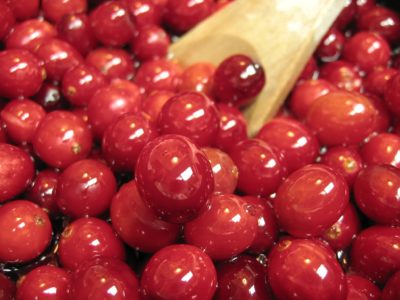Cranberries are a group of evergreen dwarf shrubs or vines, belonging to the plant family ericaceae (the same plant family as blueberries). These bitter berries are native to North America, and Native Americans were the first group to cultivate cranberries. They are naturally found in wetlands and are now grown in the unusual style of bogs (in which cranberry beds are flooded to facilitate harvesting of the berries). Their harvest is in the fall, which is one of the reasons why cranberries are featured in holiday dishes. But, I love using these berries year-round, because they freeze so well! Some of my favorite cranberry recipes include:
- Cranberry Kale Salad
- Bacon-Apple Chicken Burgers with Maple-Cranberry Sauce
- Cran-Apple Coleslaw
- Orange-Cranberry Muffins
Raw cranberries are a good source of nutrition. Per 100g, they have a good amount (16% RDV) of vitamin C, manganese (17%), and fiber (4.6g/100g). They have smaller or trace amounts of the majority of other dietary vitamins and minerals. Plus, cranberries are a good source of phytonutrients! Notably, cranberries have polyphenols, proanthocyanidins, flavonols, quercetin, and tannins. So, the antioxidant potency of this little fruit is more than just hype!
You can buy fresh cranberries during the late fall at your grocery store, or you can get them frozen any time of the year.


 Apple
Apple